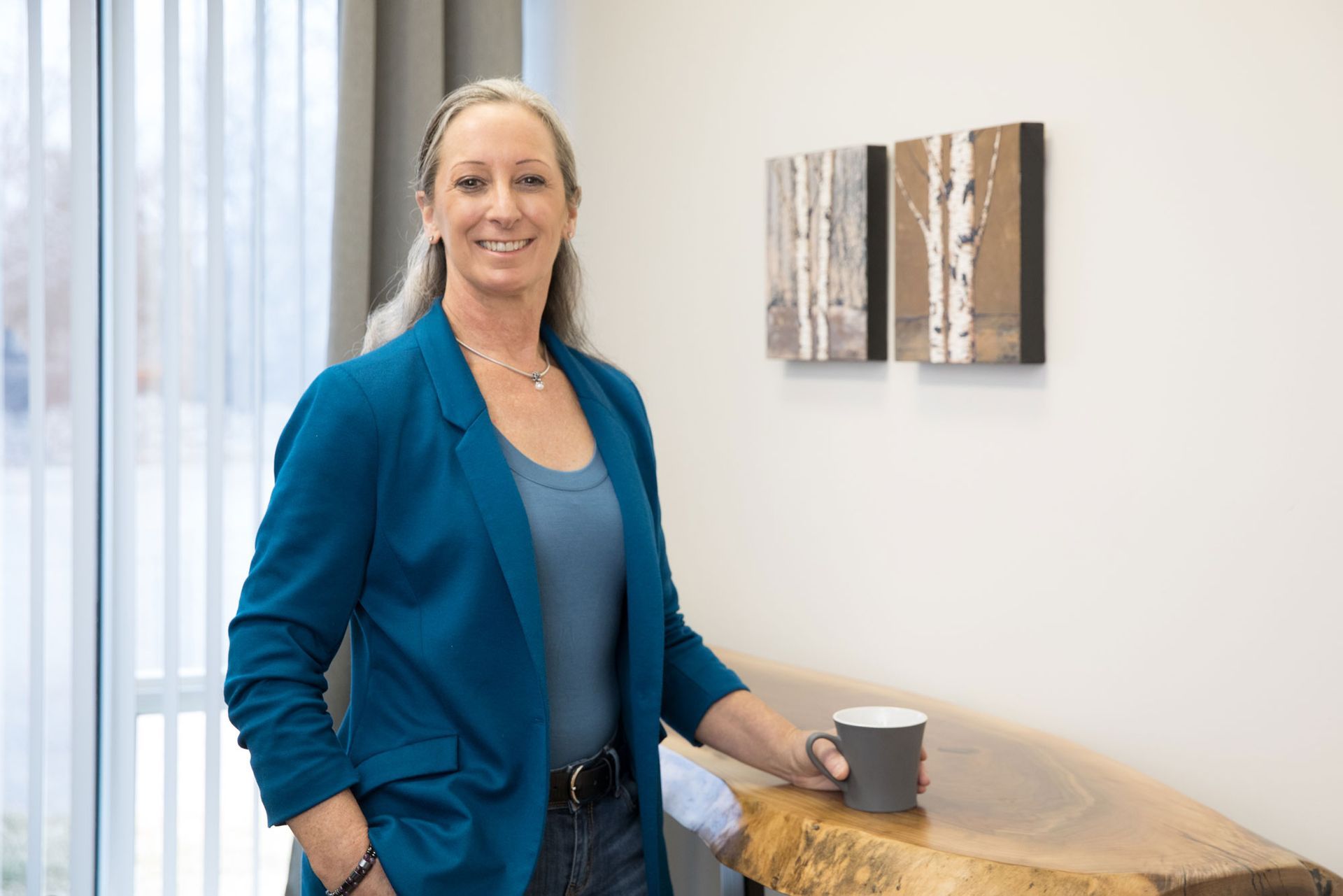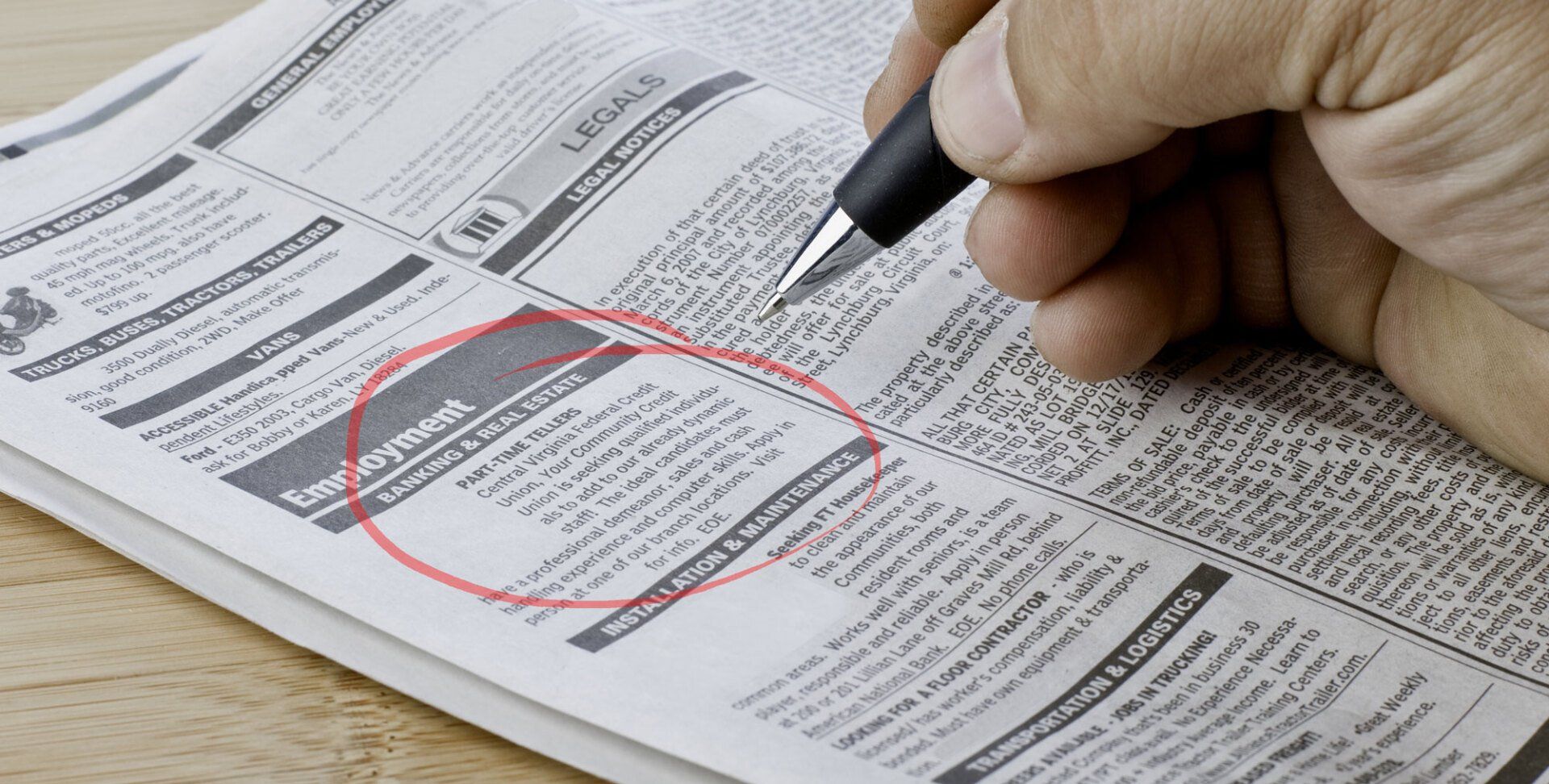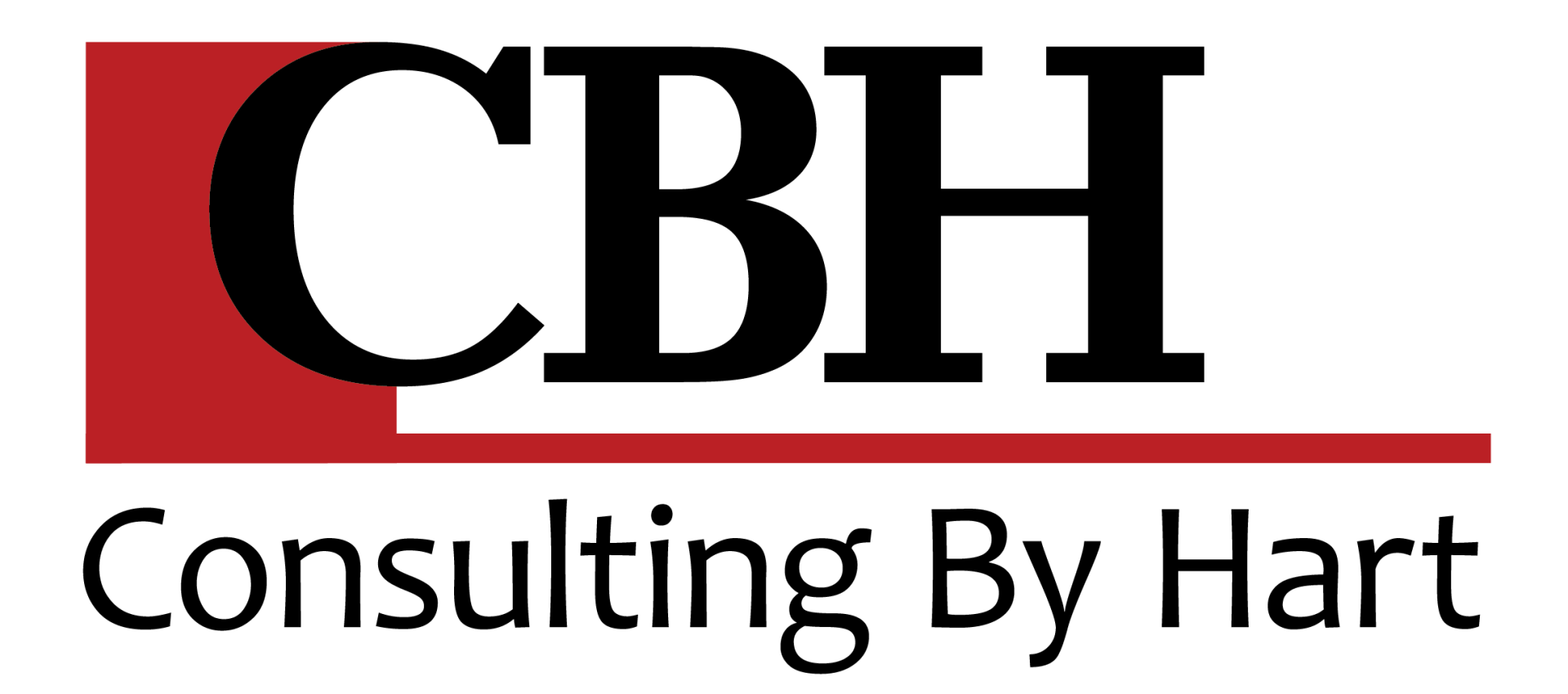BUSINESS TIPS THAT SPARK CHANGE
Resources and tools designed to help your business run smoother and more efficiently
Get focused with the CBH Insiders newsletter
You'll receive exclusive news about our upcoming events and training, as well as easy-to-implement business tips.

By Jacki Hart
•
06 Dec, 2023
It’s More About ‘Why’ Than ‘What’ you’ve done. Every now and then, I’ve thought about how many hours I’ve spent writing business columns and blogs since 2006. My guess is that I’ve written 200+ columns. Each column hovers around 1,000 words and takes a couple of hours to write, sometimes more. So, that’s like a 200,000 word essay – or a book (or two or three books worth – the average novel is about 70,000 words). And a lot of hours at the keyboard. But that’s WHAT I’ve done, not WHY. And since 2006, I’ve led and developed the Prosperity Partners Program for Landscape Ontario – two full day workshops about running a business - which I delivered to well over 800 business owners across the Province over about 8 years. That Program changed the trajectory for MANY small business owners. It also helped to provide a business blueprint for those aspiring to start a landscape business. But that’s WHAT I’ve done, not WHY. I know from 24 years of running my own landscape business, that it's easy to become overwhelmed with all of the responsibilities of running a business. And to feel alone. That’s why my husband Tim Kearney and I started the Peer-to-Peer Network for Landscape Ontario 11 years ago. And if I were counting the full day workshops and Summit’s I’ve delivered and facilitated for hundreds of Peer-to-Peer Network members, it would be north of 50 days – with another 150 days of prep and research. And a LOT of driving across the province. But that’s WHAT I’ve done, not WHY. And speaking of that landscape business of mine, we won 20 Landscape Ontario Awards of Excellence. But that’s WHAT I’ve done, not WHY. Since 2005, almost every year, I’ve been a speaker at the LO Congress Conference – to thousands of attendees, on topics ranging from engaging the team, business systems, setting goals, leadership and more. And as well, I’ve spoken at Landscape conferences and run full day workshops across the country. But that’s WHAT I’ve done, not WHY. I also sat on the Landscape Ontario Provincial Board of Directors and was elected to the Executive Committee. But that’s WHAT I’ve done, not WHY. Three years ago I took on the curriculum overhaul and continuous improvement delivery for the Employers of Choice program, with now over 300 business owners and managers working hard to implement that robust tool box for better HR management and employee engagement. But that’s WHAT I’ve done, not WHY. Focus On What's Happening Through You, Not To You. I recently read 'The Depressed Motivational Speaker by industry consultant, facilitator and long-time LO friend, Jim Paluch. And this month, I co-facilitated another Feature Congress Event with Jim for the Peer-to-Peer Network, to share some amazing strategies to build resilience under stress. The book is a must-read for business owners. One of the most striking themes for me in this story is “focus on what's happening through you, not to you”. This one simple phrase is so powerful. Without realizing it, I believe that's what I've managed to do, through lots of challenges and adversity in my own journey - always doing my best to show up with authentic advice, separated from my own stresses. Focusing on what has been happening through me rather than to me. Leaving A Legacy I never thought of my role writing blogs, or building and leading the PP, P2P or EOC programs, or speaking at Conferences, as creating a Legacy. That is until now. I don't think that we typically start our careers with the intention of legacy. I didn’t. And for me now, here it is – a time to take a look at my Landscape Ontario legacy. The essence of my ‘WHY has always been to help hard working business owners with fresh ideas and business tools, meaningful discussions, and sharing a new perspectives, with the hope that my ideas and words will build confidence and curiosity, making the path forward a bit easier, more rewarding, and more hopeful. That’s WHY. Because I believe there’s always improvement to aspire to, and the importance of being on a shared journey, together. When you look back on the lives that your career has touched, I'm guessing that you too are building your own legacy – but perhaps without realizing it – like I have. From the people that you've worked with, to the landscapes you've designed, or built, planted, pruned, cared for, enhanced, watered, fertilized, supplied, or illuminated, your legacy lies within. There are watershed moments in every career that are transformational. But we often don't recognize it at the time. Pride is our looking-glass in real-time. Legacy is our rear-view mirror. Perhaps you have heard the phrase, “it takes a community to raise a child”. I've been thinking a lot about the LO community in the past few months, and the 'children' (businesses) it has raised, both of mine included (Water’s Edge Landscaping and Consulting By Hart). This LO community has raised tens of thousands of 'children' in its’ 50 years. And just like you, here reading this Business Tips issue for maybe the first time, or the 200th, I'm grateful to be one of them. A Fond and Grateful Farewell to Landscape Ontario I am confident that all of the Landscape Ontario ‘whats’ I’ve done over the past 15+ years has offered solutions, and some inspiration to try something new for business owners and managers. And that my ‘why’ has helped many to realize that they’re never alone if they engage in all Landscape Ontario has to offer. After 200+ business column issues for Landscape Ontario, I have just submitted my last one. I am sadly retiring from all of my work with LO. I am grateful to have had the opportunity to inspire others to challenge hard working business owners and to have shared my hard-earned wisdom on running a business and a team. For your business and your team. That’s always been my ‘why’, and why I love being a business coach – which I will continue to do in the years ahead. I encourage you to take a moment to take stock of the legacy that you are building…. And to hone in on your ‘why’ vs your ‘what’. Onwards.

02 Oct, 2023
Every now and then, something comes across your desk or into your inbox that is worth paying attention to. If you’re a contractor who sells services to your customers, which include labour and materials, equipment and overhead costs, then this article is worth your time to read. Unless you are either entirely recession proof in your market, or aren’t trying to improve profit in your business. But if you are working hard to figure out a way to be more profitable, read on. Sometimes the most successful businesses have all of the cutting-edge technologies, software, apps, equipment and training. And some businesses have all of that, and still aren’t profitable enough to pay the owner well, build equity and an engaged, career-minded team. Enter J. Paul Lamarche, and his industry-altering pricing system. JPL’s estimating and pricing system was officially adopted by Landscape Ontario in 2005. In 2010, he wrote the book: What the Market will “Bare”. It is unique, because it is specific to landscaping, and is written in plain English. His system includes simplifying and explaining the most important factors in building a profitable business: Understand your true break-even costs (the point at which you neither lose nor make profit on a job). Creating a budget that includes all Overhead and Return on Investment. How to use a precise mathematical system based on division vs multiplication (don’t panic until at least you’ve checked it out!). How to record accurate overhead allocations, including items that are not part of your record keeping and/of cheque payment system. How to calculate return on Investment (ROI) for all vehicles and equipment. How to do a quick breakeven analysis when quoting a job (So that you know how low you can go on your price and avoid working for free – which is especially handy coming into a recessionary trending economy). How to deploy a simple, inexpensive estimating system using the calculator on your phone and a few important basics. In this easy-to-follow book, the main premise is that if your company has no debt load, then you’re more competitive and have a lower cost of doing business, which leads to more profit. The trick is how to get to no debt load (i.e. leased or financed vehicles/equipment) from where you are now, and stay there. When I first heard about JPL and his mathematical system 20 years ago, I went to a few seminars, glazed over when he started doing math on a white board, and left, thinking that I could figure it out on my own. Several hard and low-profit years later, I called him and hired him to come into my business as a consultant. It was 2007. I was 15 years into my landscape maintenance company with 20 employees, doing a million in sales, and made about 6% profit (EBITDA) after I’d paid myself fairly well. I wanted an exit strategy. I wanted to find a way to build value in my company, and have it run without me working 80-hour weeks. I wanted to prepare my business to sell. From the easy-to-use formula’s in this book I learned to build a budget, right-size the fleet and equipment, charge properly, eliminate ‘leakage’ on labour and materials, and gain ROI on my investment in the fleet. By 2014, I had only grown sales by 10% (by choice), but I reduced the number of staff by 25%, increased my own pay by 20%, upgraded the ‘fleet’ with no debt load, had a team of 3 managers (admin, sales and ops) running the day-to-day and increased profit (EBITDA) to 18%. By the time I sold the business that year, I was only at the office 1 day a week, and selling the higher end soft landscape projects 2 days a week on a 6-figure salary, with six figure profit on top. “What the Market will BARE” was my blueprint for success. At first, it was a bit daunting, but taking the time to go one chapter at a time, one example at a time, and learning the ‘math’ was well worth the effort for years to come. In this book, you’ll learn: How to calculate your overhead and ‘break-even’ How to calculate your true labour costs, including labour burden Benchmarks – and how they relate to your business Understanding the difference between markup and profit margin Setting a budget to guide your pricing Understanding Return on Investment Here’s just one example of a mistake in pricing that’s made by the majority of business owners, that this book teaches the reader to correct: You buy a load of plants for a project that cost you $1000. You decide that you want 30% profit on them. So, you take the $1000 you spent, and multiply it x 1.3 which = $1300. So you think you have a 30% profit on the plants. Right? But you don’t. $1000 (what you spent) divided by $1300 (what you charged) = 76.9%. So, if what you spent to buy the plants is 76.9% of what you sold them for to the customer, then the difference, 23.1%, is your profit. Wait. What??! Look at that again. You just short-changed yourself 6.9% (the 30% you want minus 6.9% you miscalculated), profit on your materials. For most companies who make less than 10% profit overall, this places them on the hairy edge of ‘lower than hoped for’ profit. However, if you were to read ‘What The Market Will “Bare”, you’ll understand that division is the key to profit margins, not multiplication – as used in the example above. Here’s the division example: You buy a load of plants for a project that cost you $1000. You decide that you want to make 30% profit on the plants. So, you take the $1000 you spent, and DIVIDE it by (100% - 30%), which equals 70%. ( This means you take $1000/.7), which = $1428.57 as the price to charge your customer. So you now have a 30% profit on the plants… the $1000 you spent on the plants = 70% of what you charged for them. This is just one example of simple corrections you will likely make to your business every year, sometimes every day, on pricing and profit by reading and applying this industry-endorsed pricing system. There are many more valuable lessons in the book, that will touch on and fix leakage in all corners of your operations, improve the decisions you make, and correct your pricing. On a personal note: Paul was not only my business coach, we became friends, meeting for lunch several times each year to ‘catch up’ on business, for over ten years. He helped me sell my landscape company, and he mentored me in setting up my consulting business. Sadly, Paul passed away in June of 2020 at the age of 70. His widow, Stella, has kindly offered to give all of the proceeds of the sale of Paul’s books to the Landscape Ontario Scholarship Fund, to support education of our newest up and coming landscape professionals. I hope that you purchase one, and improve the profit in your company.

By Jacki Hart
•
06 Jul, 2023
In last months issue, I discussed one part of the pandemic hangover – the impact of inflation on our workforce. If you read it, hopefully you’re well on your way to leveraging the strategy of paying at least the ‘living wage’ for your area vs the ‘minimum wage’. Here is Part 2 of the post-pandemic impact on our workforce: the degree to which your potential workforce is willing to ‘work’, their definition of ‘work balance’ and their ability to navigate stress. The Lifestyle-First Habit Without a doubt, the Work From Home (WFH) trend has changed the mindset of a scary percentage of the workforce across the country. Everyone I’ve asked in my travels this year, knows someone who still works from home (either hybrid or full time), who would previously have always gone to an office or place of business ‘to work’. Along with this trend, comes the ‘oh I can do laundry, make dinner and walk the dog (literally and figuratively) – while I’m getting paid working from home’. While the corporate world is busy creating policies on RTW, dragging unwilling employees back and creating consequences of the refusal to return to the office, employees and legislators are figuring out ways to force employers to pay huge termination settlements if employees refuse to return full time, and many employers are being forced to concede to hybrid arrangements at the expense of productivity and profit. What does all that have to do with employee retention in the Landscape Professions? Lots. During the pandemic, many had to be creative to make ends meet. And many benefitted from government subsidies for a LONG time. Employers did as well. This new reality plunks us squarely into an economy that’s navigating higher interest rates, less discretionary spending, unleashed inflation, and new habits of staying closer to home – for a living. For most employers for whom I write this column, staying home means not getting paid. So, we have a workforce that in many ways want or expect to be able to continue this new habit of managing their lives conveniently, which includes fitting the personal ‘weekly tasks’ within the work week – so that weekends are free for friends and fun. Add to this, the ever-changing interests of Gen Z (18-30 yrs) whom are less likely to stick to one job for more than a short period of time, and we have a workforce retention challenge that puts us into a whole new ball game. The New Retention Landscape When the going gets tough, the leading entrepreneurs get creative. Now would be a good time for you to join them. What this all means to seasonal businesses – is that the model of a workforce willing work 45+ hours a week for 30-ish weeks a year and then fend for themselves the rest of the time, is officially now defunct. So is the model where employees must be willing to work 5 days a week, starting and finishing at the same time every day, and the same time as everyone else, or there’s no job offer. Reset your thinking. Employee retention is now inextricably linked to the ‘lifestyle balance’ and ‘stress minimization’ that your company affords them. This means having conversations about wants and needs. And about the stress that each employee is navigating outside of work. (Yes, you read that correctly.) It means having new policies on ‘days and hours of work’. Policies which include room for flexibility and customization from one employee to the next. It means building empathy into attendance policies. It means that ‘training’ has to be a confidence builder and not a source of anxiety when paired with the quick addition of responsibility. It also means ensuring that employees know that they have to show up when they say they will – I’m seeing successful employers negotiate convenience (for the employee) with dependability (for the employer). The hardest part of this is that employers are being pinched tighter on margins, to make room for more people on staff at any given time and a more complex scheduling regimen to balance it all on the customer-facing side of the business. At a time when employers feel the need to improve ‘efficiency’, many employees are feeling the need to rest more and stress less. If paying the Living Wage is step one to retention. Then post-pandemic ‘lifestyle balance’ is step two. The reality is, the higher percentage of staff under the age of 35 that a company employs (I’m stereotyping here – yet it’s a clear trend), the more likely it is that a significant number of staff are walking out the door because either your workplace is too stressful for them or their home/social life is. Some of you reading this might roll your eyes and think ‘so what does that have to do with my company’…. To you I ask this: “How’s retention going for you?” In all likelihood, I’ll hazard to guess, not very well. This is a time to slow down in order to go faster. Slow down and talk to your staff. One on one. Informally. Go for a coffee. Pick them up during the workday and go sit on a park bench. Care, and show it. You don’t need to act as a therapist – but you could direct them toward one if you think it would help. You don’t need to be a ‘parent’, but you might want to keep a box of Kleenex in your truck. Sometimes people just need to know you care. If you do, they will trust you. If they trust you, they will be more likely to stay. If they stay, you grow bench strength and minimize the need to recruit and train. Think about it. Retention. It’s not only about the money. It’s about belonging. It’s about personal ‘safety’. It’s about being a part of a social network that is supportive. It’s about realizing that the employers’ role has changed for the foreseeable future. Honest.

By Jacki Hart
•
05 Jun, 2023
There are many ways in which The Pandemic left a lasting impact on our profession. Some have been extremely beneficial while others are applying pressure to profitability and team retention. Among some of the strongest legacy benefits we’ve experienced in the last few years, the one that stands out in my mind the most, is the elevated consumer/home-owner awareness and appreciation for the benefit of landscapes and pleasant outdoor spaces. There was a huge increase in demand for residential landscaping – at all levels – and the related the ripple effect that spread across all green profession sectors – drove unprecedented sales, when many sectors in the economy were shut down or drastically restricted. We have also seen an unprecedented influx of jobseekers – from both the sectors (ie food, entertainment, travel, retail) that were deeply restricted, and from those sectors where workers realized how much ‘safer’ they felt to work outdoors. Along with this worker migration, has also come labour shortages in manufacturing and logistics – among other pressures driving inflation to levels we haven’t seen in decades. With higher costs of living comes demands for higher wages to make ends meet. Many of you reading this column are living this new reality – which is putting an unprecedented squeeze on the gap between labour burden costs, and charge out rates. While we’ve never before (at least not in my 43-year green industry career) been poised to leverage this level of increased demand and respect for our products and services, it is somewhat bitter-sweet. In order to meet increased demand, the pressure is on us to attract, acquire and retain great team players like never before. And we need to be competitive in our wage rates, benefits and perks. Enter the Living Wage. It’s now a ‘thing’. And it’s a powerful recruiting tool when properly leveraged. Consider this map, and check in on the ‘living wage’ currently posted for your area:

08 May, 2023
If you find yourself asking this question at the end of every year, you’re in good company. Many small business entrepreneurs (under $10M in revenue) work very hard on the operations and sales of the business, keeping all of the balls in the air to ensure customers receive great service and pay their bills on time. Often, working ‘in’ the business trumps working ‘on’ the business. Herein lies the problem. We all gravitate to do what we prefer. And most entrepreneurs lean away from ‘the numbers’ and the nitty gritty details of actions and decisions that build a healthy balance sheet (and bank account). While operational excellence is important, unfortunately, neither the balance sheet nor overhead recovery factors can perform at their best when left on autopilot. What the heck is ‘overhead recovery’ (OHR)? It’s the act of making sure that the company’s ‘fixed costs’ are fully recovered in the prices charged to customers for products and services. Notice I said that it’s the ‘act’ of recovering costs. It doesn’t happen automatically, and unless you intentionally add the right % to your costs of good sold (COGS), PLUS a margin for profit ( see my last column ) into the price you charge your customers, you will always fall short of the money you’d hoped to make. Here’s why it matters: For most entrepreneurs, both the business and the value that’s built into it over the years, is the retirement ‘pension’ plan and security. Whether planning to develop a business for sale, or for making additional acquisitions, taking on partners, or franchising – eventually, the track record of profit and assets acquired determine the value of the business in the future. And the ‘retirement plan’ cash flow. So, to get there from here, overhead recovery (OHR) and Return on Investment (ROI) are important - so let’s take a look at the basics: We commonly refer to numbers on the Profit and Loss statement as either ‘above the line’ or ‘below the line’. The ‘line’ is Gross Profit. Gross Profit is calculated from the numbers ‘above’ it on the P&L: Sales minus the Cost Of Goods Sold (materials, equipment, field/billable labour, subcontractors) = Gross Profit. Depending on how your accountant has set up your chart of accounts, you may have to do a bit of fiddling around with numbers to be able to compare your COGS, Gross Profit and OH Expenses on the P & L (income statement) with the industry standards method. Accountants typically put field labour into ‘expenses’, ‘below the (gross profit) line’. If you want to benchmark along side your peers, then you’ll need to move it up ‘above the line’. Everything in ‘overhead expenses’ should be ‘fixed’ – and not proportionate to sales. Here are a few examples of overhead expenses: rent, utilities, communications (phones, internet, software etc), small tool purchases / shop expenses, business insurance, professional services, bank charges, management and admin salaries / vehicles (not billable in the field), etc. Note that truck lease expenses aren’t in this list. If you have 1 or 2 trucks leased, it’s ok to include them and their related costs here in ‘overhead’ for a SORS (Single Overhead Recovery) method ‘below the line’. If either your trucks or equipment are financed, their loans will appear only on the balance sheet. If you have a larger fleet, all field trucks, equipment and their related costs should be reported ‘above the line’ in Cost Of Goods Sold. So, let’s use an example on calculating OHR: If sales are $700,000 (100% of revenue), COGS are $455,000 (65% of revenue) and Overhead Expenses (including owner’s salary or income) are $175,000 (25% of revenue), then profit would be $70,000 (10% of revenue). So to price a contract that includes recovering overhead, in this example, here’s the calculation: Let’s say that the Cost of Goods Sold for a soft landscape installation = $2500, and you want to make 15% profit after recovering all of your ‘overhead’. Using the JPL formula I explained in my last column , here’s answer: 100% minus 25% = 75% $2500 divided by 75% = $3300. So, $3300 is your BREAK EVEN Cost. Then add your desired profit of 15%: 100% minus 15% = 85% $3300 divided by 85% = $3882 is your price to your customer. If you use the incorrect, but commonly deployed ‘markup’ method, your price to your customer would be $2500 x 1.25 (to incorrectly ‘add’ 25% Overhead recovery) = $3125 Break Even price x 1.15 (incorrectly ‘adding’ 15% profit) , your price would be $3593.75. Which would have left $288.60 in the customer’s pocket instead of yours. So, on $2500 worth of labour, materials etc, if you don’t properly recover overhead and profit margin, you have fallen short of your profit projections for the end of the year by almost $300 bucks. Many of you reading this might be glazing over, and you might not have actually read the numbers, thought about them and tried it on your own calculator to see if I had a typo. And you might not yet have tested this out on your own P&L against your own quotes. I’ll encourage you to suck it up and try it. If you are falling short of your goals, then please re read this, and my last column which you can find here . Use your budget for the year, and at the very least, if you don’t have one, then use your Quickbooks Profit and Loss Statement to get your total Overhead Expenses as a % of the total sales from last year, and make necessary adjustments to forecast your best guess on how things will turn out this year for Overhead Expenses as a % of sales this year. Recover your company overhead in every charge-out hourly rate, and every material or subcontractor cost you incur on a job. You work hard. You’ve earned it. You just might be lousy at math is all….

23 Feb, 2023
Many of my readers remember JPL. Jean Paul Lamarche. The North American Landscape Industry guru on overhead recovery. A brilliant math genius. A passionate landscape designer and contractor. One of our professions’ all-time top mentors on landscape business profitability, production rates, pricing and retail success. JPL passed away several years ago. He was my mentor, and my good friend. Every winter, I spend most of my time coaching business owners on improving profit. And, I deploy JPL’s formulae weekly if not daily – mentoring landscapers on simple math – and it’s actually not that painful. I realize that many if not most of you have settled on your 2023 pricing, hourly charge out rates, equipment day rates, wages and salaries to staff etc. Many have sent out contracts months or weeks ago. What I also know is that there’s going to be lots of new business come your way this year – new customers, new accounts, new referrals and new employees. My question to you is: Will you price your newly acquired work as the season wears on the same as the work you’ve already sold now? There are many different ways to determine what to charge and what to pay staff. Some business owners use what I refer to as the ‘dartboard method’, which deploys a mixture of guess work, intuition and knowing how to stay below the competition on price. Others use budgeting software – which can be either a very valuable tool to support profitable pricing, or a weapon to destroy it if not properly used. ‘Pie in the sky’ budgeting can be more disastrous than no budget at all – because it gives a false sense of success that never materializes. Some business owners use spreadsheets which track recent and projected Sales / Costs Of Goods Sold / Overhead – line by line – to determine best predictions on profit margins. It always amazes me at how much variation there is to the methodology, and related success. Unfortunately for many – figuring out how important both proper budgeting and overhead recovery methods are – comes too late, and the business closes down. And also, I am amazed every year at how hard working many business owners are – year after year, without decent profit or return on their investment. So, I thought I would share a few classic JPL ‘aha’ moments for you to consider going into this year’s pricing strategy on ‘markup’ and recovering overhead. Starting with ‘mark up’ here’s an example. Let’s say you have materials and labour on a small project that in total cost you $1000. Labour, Labour Burden, Materials (Cost of Goods Sold or COGS) plus overhead recovery. And you want a 20% profit, so you’d likely ‘mark it up’ 20%. If I handed you a calculator, and asked you to add 20% profit to those costs most typically take $1000 x 1.2 = $1200 as the price to the customer. Right? Does that give you a 20% profit? Nope. It gives you only 16.7% profit. ($1000/$1200 = .833 as the cost of the materials, which means .167 x 100 or 16.7% is profit) You just left 3.3% profit on the table. When most landscape companies average 2-3% profit (as reported by LMN), that’s a problem. The proper way to calculate ‘profit’ added to Costs of Goods Sold is this: $1000 / .8 = $1250 as the price to the customer. $1,000 / $1250 = 20%. Why divide by ‘.8’? Well, 100% minus the 20% desired profit = 80%. So if you divide by 80%, what’s left is the 20% you’re seeking. Look at the numbers here….. 1000 is 80% of 1250. Right? Right! So if you use a multiplier of 1.2 to get a ‘profit mark up’ of 20% on a $1000 COGS job – you left $50 on the table. If it’s a $10,000 COGS job – that’s $500 out of your pocket – if it’s a 100,000 job COGS , that’s $5000 profit you thought you’d priced in your ‘markup’ but didn’t by using a multiplier of ‘1.2’. If you want 10% profit, divide your $1000 project costs (including overhead) by .90 = $1,111 price to the customer. If you want 15% profit, divide your $1000 project costs (including overhead) by .85 = $1176 price to the customer . If you want 25% profit, divide your $1000 project costs (including overhead) by .75 = $1333 price to the customer . I think you get my drift here. While the difference seems small – think of a company with $500,000 in sales, with overhead properly recovered (see this column next month) and looking for a desired profit of 15%: With the incorrect ‘profit markup’, $500,000 x 1.15 = $575,000. With correct profit margin calculated, $500,000 / .85 = $588,235. On $500,000 in sales, $13,235 is left hanging in the breeze, not in your bank account. That’s 2.65% more profit just by pricing correctly for the profit you thought you were going to get. That’s the hairy edge margin that many companies surf between break even and having enough money to get through the winter and keep going. I hope that instead of managing disappointment at the end of this upcoming landscaping season, you’ll be happier with profit, by using the right math to calculate the profit you’re after.

21 Nov, 2022
Many of you have likely heard me speak of this concept in the past…. So I thought that I would round off the year with a little reminder. As we near the end of a year that started with COVID-19 lockdowns, and ends with hope that we are rounding the bend toward a hopefully more ‘normal’ business year ahead, my attention is focused on how I can best support entrepreneurs and managers into 2023. The answer lies in the wisdom of the 7 Most Expensive Words In Business. After travelling to speak at conferences from coast to coast this past fall, plus hosting the 2-day Peer To Peer Network Muskoka Summit – all of which were focused on ‘solving the staffing dilemma’, I’m absolutely sure that solving the workforce dilemma AND improving employee engagement is crucial to a successful 2023 across both the provinces, and all sectors. The solution isn’t easy. It requires a paradigm shift in thinking. Industry wide. Those who know me, have heard me talk about this for several years now. I’ve seen it coming, and I’m frustrated by the resistance to change from literally hundreds of business owners and managers I’ve engaged on the topic this year. I’m going to give the following example for the Landscape Profession – as over 90% of my readers are in some way related to that industry. Listen up. I truly believe that we are in all poised on the cusp of a moment in our profession that’s unprecedented in many ways: 1. We have momentum of consumer engagement in the value of the plants and landscapes we create and manage – like never before. A positive legacy from COVID-19. 2. We have momentum also in credibility for our contractors – with whom millions of homeowners across the country have engaged like never before through COVID-19. 3. We are finally positioned to ride upward trends on pricing – where every customer will totally understand that our costs have soared exponentially along with everything else around them. Inflation out of control. Now is our moment to raise prices so that we can properly pay our staff. 4. Despite increases in interest rates, and increase in travel, consumers (primarily residential) are still showing more interest in ‘when’ than in ‘how much’. If you have it, they’ll buy it. If you can meet their timeline on a project, most prefer that to bickering on price. 5. Government subsidies and funding for Apprenticeship training have never been higher for supporting the costs of training your willing employees. 6. The GROW Program is unprecedented in preparing new employees for you , and for training budding supervisors – all for FREE. 7. There is public awareness of climate change, carbon emission targets, flood mitigation, pollinator threats, habitat loss among many other issues that is unprecedented, and ripe to leverage our contribution to solving each of these issues and more. 8. There is also a generation called Gen Z (under 28) who are willing to show up engaged, aligned, interested and growth oriented – if you make the effort to shift your thinking and adapt to meet them where they are starting from, and be the life coach they need to succeed. I know that the biggest stretch for most owner/manager is to trust in that last bullet point. I’ve personally witnessed it Coast to Coast in Canada yet again this year. I know for sure that if your company has a staffing dilemma, then it’s more the fault of your approach to attracting hiring and retention than anything else. In order for our Profession’s business owners to leverage this moment to it’s highest potential it will require avoiding the 7 most expensive words in business: “Because We’ve Always Done It This Way”. Short staffed? It’s not necessary to stay stuck there. You do have options. Those employers who ‘get it’, aren’t short staffed – so I’m not making this up. FYI, Gen Z represents 29% of Canadians between the ages of 15 – 65. And they’re showing up with a different life skills tool box than what you need them to have (because you may have had stronger life skills ‘at their age’), when they come onboard with your business. The bottom line? 2023 is your chance to up-level your business – despite any downward economic pressures you might need to navigate and despite your 2022 ‘we can’t find good staff’ mantra. Carpe Diem. Seize the Day. 2023 is going to be ‘Our Day’ in the history of our profession. We will rise to the top. We have hope like never before. We will be proud like never before. I can feel it. I can see it. Go out there and be the best you can be, showing up as leaders who inspire, protect and grow our next generation like never before. You’ve got this. If you want to. Carpe Diem.

27 Oct, 2022
After 5 years of focusing my attention on the behaviour differences between generations in the workplace, I’ve come to a few conclusions. Let me explain. There’s a long list of reasons why I’ve come to believe in these conclusions – which I don’t have the space to explain here. Instead, I’ll share the highlights (I’d like to say ‘Coles Notes’, but my Millennial and Gen Z readers might roll their eyes and stop reading.) . 1. The ‘Millennial Problem’ isn’t a problem in the least. It’s an opportunity . For the last 10 years, many employers have thrown their arms up in despair and frustration at trying to understand how to work with Millennials. It’s actually not that hard. And, they’re not lazy. They’re not self-entitled either. Millennials are highly creative, and prefer t o work as a part of the ‘hive mind’ collective. They want to collaborate. And they need encouragement – in real-time, and often. They are now in their late 20’s through early 40’s. The employer / employee clash comes when Gen X and Baby boomers are operating with the old paradigm toward work in our profession – commit to the company, show up, work hard, pull your own weight, hit the targets/metrics you’re told to achieve, get your cheque, and as for feedback, well no news is good news now then isn’t it!? Well, actually, no, not any more. If you’re a Gen X (early 40’s thru late 50’s) or Baby Boomer (60-ish thru early 70’s), then you’re likely frustrated with the ‘attitude’ of most ‘young people’ that you hire because of the work ethic you perceive them to have. And the Millennial employees who find themselves in the midst of companies led like that, run screaming in the opposite direction, in search for a workplace where the will be treated as a collaborative and valued person on the team – from day one. As for the ‘show up’ part – Millennials are social, and community minded – they crave being valued and appreciated. If there’s something in their personal life or circle that trumps your targets and budgets, then they’re likely not showing up for you every day. And they dislike conflict – so if they know they’ll get ‘in trouble’ for taking a day off – they just won’t call in and get the hassle, they just don’t show up and then based on the reaction when they return to work – they either shrug it off or leave altogether. They rarely will work the long hours in a day or week that you might. But they will work as hard, if you meet them on their terms. Paid time off is a great example of helping Millennials feel more committed to the company. Paid time to do a community / volunteer project can be a very sticky benefit to offer. 2. Gen Z is wired differently than Millennials. Very differently . This cohort (now in their mid 20’s and younger) aren’t as ‘needy’ as millennials may seem. They aren’t as set on being a part of a collaborating, co-creating group. This generation has a bit more independence. They want to know how they are doing, and measure their own progress or success on individually assigned projects or goals – or on their own ‘part’ of a workday team plan. And, this generation is also highly curious, and extremely protective of their life-work balance. Note that ‘life’ comes first here. They are timid, curious, social and a bit flighty. Easily intimidated. Sensitive to criticism of either themselves or of others around them, if it is not accompanied with coaching for improved results. They aren’t afraid to learn but they insist on feeling they’ve been set up for success. If they don’t, they’ll bolt for the door. Culture therefore, is critical. This generation needs to feel autonomy – a tough challenge for employers running crews, and welcoming ‘entry-level’ workers into a company that’s set up with a hierarchy of levels of authority and control. The companies that are successful engaging this vibrant, bright and curious generation, are those who have shifted the leadership paradigm around the meaning of ‘hard work’ and ‘life balance’. And if you want to have success building the team you need, then get with this program – Life Work Balance. Ask them what that means to them, and engage in the conversation. 3. Motivating the team is only a challenge when the generation trying to motivate has a different paradigm around what’s meaningful and important . I was recently coaching a husband and wife business owner Millennial team. They were asking for advice on motivation. After proudly describing a bonus system they’d devised for their teams, including how the shared ‘leader board’ displayed employee ‘points’ earned on performance each month – and who was ‘leading/winning’ the contest, I asked them if the program worked. They both laughed and said it was an absolute failure. One of the terms they kept using was ‘here’s the numbers we need to meet’. BINGO. Externally defined, meaningless goals in a bonus system based on achieving numbers that were meaningful to the owners – not to the team. AND, a system designed to publicly shame those who were struggling to meet or compete with the targets. Doomed to fail. The team btw are mostly younger Millennials and Gen Z over 20. The solution we discussed was Gen Z-based thinking: Stop talking about gross profit or job costing targets up front. Start talking about what is scheduled for any given crew for a week, and let them figure out how to get the work done on time, and to standard. Consider setting in place more of a ‘salary’ than ‘hourly rate’. It’s easier than you might think. Seriously, as an employer, if you were to turn it around into a Gen Z context – and say ‘I’ll pay you $X.xx per week for the season. Some weeks will be heavier than others depending on the time of year. The attention to detail has to be met. The schedule will be reasonable. If you and your team mates can figure out a way to get the work done at or above standard, in less time, then you get paid time off. ‘ I.e. be super efficient and diligent, show up and dig in, and you can get hot or rainy days off, or half days, or Fridays off , or start later each day – etc. Individually motivated to get what they want – more time off – and steady paycheque. BINGO. If you’re struggling with finding the motivation miracle – My suggestion is simple: Look in the mirror. If you see any grey hair, odds are that your company might be running ‘behind the times’.

22 Sep, 2022
Ahhh yes. Generation Z. That wonderfully energetic project-focused generation amongst every company, who are under the age of 29. A tricky bunch – if you’re an employer over the age of 45. The statistics show (gallup) that they will change jobs at least 3 times more often than their older cohorts – Gen X and Baby Boomers. So what does this mean to you? It means that you have to adjust your recruiting strategy to reflect this new reality. Because, it’s not going away any time soon. Job hopping is here to stay. For the most part. Careers look different now than ever before. We’ve shifted from Boomers and Gen X learning a trade, graduating college and expecting to have a long career with a single employer – at the end of which we would get the customary gold watch and a pension. The ‘status quo’ was that companies could count on a steady and long-term work force and their employees would enjoy a lifetime of predictable income and benefits. Fast forward to 2022, and we find a career-driven generation who know their worth, who are taking advantage of the job seekers market, and who don’t accept status quo. If you want to attract, hire and retain them, you have to get with the program. The Gen Z Program and meet them where they are. They’re not going to have it any other way. In the absence of any handy Canadian statistics on this topic, I look south of the border to the Bureau of Labor Statistics for context and research: I found that the median tenure of workers aged 55-64 is 10 years, while of the 25-34 age group – it’s 2.8 years. Short term job seekers are here to stay with this cohort looking to change employers in less that 3 years and only a quarter of them looking for a 5+ year opportunity in the same company. Also, over a third of them expect multiple job offers every time they look to switch jobs - which they do whenever they’re looking for meaningful work where they can make an impact, learn new skills and build on their work experience for their next gig (i.e. ‘what’s in it for me if I work for you’?). They are bold and fearless of new situations and aren’t afraid to pursue a new opportunity. Why is this a big deal? Worth noting, Gen Z and Millennials combined make up over 40% of the current work force. And the cost of high turnover might be higher than you think: according to labor statistics by the Center for American Progress , the cost of losing an employee can range from 16% of what you pay them annually, to 213% for highly trained positions. These include costs for people on your team, who already have other work to do, to be attracting, hiring, onboarding, and training new recruits. I encourage you to stop and think about that for a moment… If up to 40% of your team are either leaving or new every three years on average – this cost is having a huge, and possibly uncalculated negative impact on your bottom line – not to mention team morale and customer confidence. So now what? I think that the best way forward is to develop a recruitment team who are focused on developing candidate pipelines and focus on trendy strategies for employee retention. The key is to be building long-term strategies that not only respond to job hoppers, but that stay one step ahead of them. How can you do this? Here are a few tips to help you attract the right candidates, build a strong hiring brand, and be the winning employer when candidates have multiple offers Create a ‘candidate relationship’ strategy, to continually foster relationships with candidates throughout their career journey, even if they don’t accept your offer – the first time. There are software products out there to help you manage ongoing relationships with candidates. Keep the door open, even if they don’t accept your offer. They might be back if things don’t work out, or if they decide to give you another try. Promote how candidates will making an impact and enjoy meaningful work. We know that Millennials and Gen Z both prioritize salary and work-life balance as the most important factors when considering a new job. One big difference though is that Gen Z places increased value on job duties or projects where Millennials look for career growth opportunities. Job ads could include specific timelines and plans with actionable first steps a candidate could take once hired. Slow down to go faster. Taking less time to hire is the end goal, after retention. Reduce costs of attracting recruiting and onboarding by creating a ‘rinse and repeat’ process. Make sure that you ‘bake in’ questions that identify potential bad hires early on in the process. There’s a high cost associated with constantly returning to the drawing board on hiring. There are even higher costs of being short staffed/ limited in fulfilling your client service obligations. While I realize that even the best hiring questions can’t prevent you losing a great worker who prematurely heads for the exit , I believe that you can proactively minimize the risk of an unexpectedly open critical position. So, as you head into the next season, ask yourself, ‘What can we do to best ensure our business isn’t caught flat-footed when it’s time to find a quality replacement or make an addition to our growing team’? ‘What can we ‘rinse and repeat’ in our recruiting process?’

02 Aug, 2022
With ongoing challenges in recruitment and retention of employees, I think it’s a good time of year to check in with how your employees are feeling about their work with your company… and what’s ‘next’ for them – and you. The challenge with starting to explore ‘what’s next’ with your younger team members (Gen Z, the under 25’s in particular), is that without being properly prepared, you might be opening up questions with them for which you haven’t yet developed great answers. This column provides a glance into a framework worth considering to help you have that ‘what’s next’ discussion successfully. When working with a coaching client on developing career paths recently, I realized that many employers simply either haven’t yet or don’t know how to chart a path for employees to follow. To help you chart that path, I want to throw out a company structure idea: Agile Cooperative vs Top Down Hierarchy. An agile cooperative is a type of company structure, where the responsibilities of each person are very clear, and different people make different types or ‘levels’ of decisions based on skills and knowledge (capability). Instead of the ‘top down’ structure where information mostly ‘flows down’ to the field workers / labourers, think more of a wheel with spokes than an organizational chart with different levels of seniority. In an agile cooperative, the number of years of tenure rarely equate to a raise or promotion. Raises are tied to merit, skill, knowledge etc. Charting out an employee pathway starts with first being crystal clear on what their (or any) company position requires for skills and knowledge. In additio n, it’s also pretty tough to entice young workers to stay when they haven’t yet realized that there are three key ingredients to earning more money or responsibility: 1. Skills. 2. Knowledge. 3. Will. Having just two of the three doesn’t cut it. To keep the people you have, they need to know ‘what’s in it for me if I stay? My answer to that is typically something like: “Well, that’s pretty much up to you”. With clear job descriptions that describe each role, the responsibilities, the required results of effort, the skills and qualifications – then you can show the path forward (note – I didn’t say ‘ the path upwards’). Here’s an example (with very approximate* pay rate ranges):
Stay connected with us!
© All rights reserved. 1946129 Ontario Limited. Terms of Use |
Privacy PolicyWebsite Developed by
Client First Web Design and Graphics
© All rights reserved. 1946129 Ontario Limited. Terms of Use |
Privacy Policy
Website Developed by
Client First Web Design and Graphics

